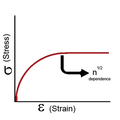Work hardening
The work hardening, also known as strain hardening, is the strengthening of a metal or polymer by plastic deformation. The plastic deformation of the metals is made below the recrystallization temperature. In most cases, such cold forming is done at room temperature. The major cold-working operations can be classified basically as squeezing (rolling), bending, shearing and drawing.[1]
The cold-working process uses the pressure and speed of a mechanical or hydraulic press. The press takes a metal ‘blank’ and shapes it using a ‘punch’ and ‘die’ set. Basically, the punch is the tool used for shaping, and the ‘die’ is the clamp that holds the metal. When these metals are cold worked, permanent defects change their crystalline makeup. These defects reduce the ability of crystals to move within the metal structure and the metal becomes more resistant to further deformation. The resulting metal product has improved tensile strength and hardness, but less ductility.[2]
Cold working can be used on a variety of metals, including aluminum, copper, brass, steel, and stainless steel.
Work Hardening Media
References
- ↑ "A Short Overview Of Metal Cold Working Processes". elemetmfg.com. 7 April 2021. Archived from the original on 2021-11-05. Retrieved 2021-11-05.
- ↑ Kumar, Amrit (2021-03-04). "Cold Working: Definition, Methods, Working Process, Advantages, Disadvantages, Application [Notes & PDF]". THEMECHANICALENGINEERING.COM. Archived from the original on 2021-11-05. Retrieved 2021-11-05.
